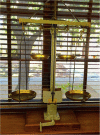Discovery of the magnetic behavior of hemoglobin: A beginning of bioinorganic chemistry
- PMID: 26508205
- PMCID: PMC4629386
- DOI: 10.1073/pnas.1515704112
Discovery of the magnetic behavior of hemoglobin: A beginning of bioinorganic chemistry
Abstract
Two articles published by Pauling and Coryell in PNAS nearly 80 years ago described in detail the magnetic properties of oxy- and deoxyhemoglobin, as well as those of closely related compounds containing hemes. Their measurements revealed a large difference in magnetism between oxygenated and deoxygenated forms of the protein and, along with consideration of the observed diamagnetism of the carbonmonoxy derivative, led to an electronic structural formulation of oxyhemoglobin. The key role of hemoglobin as the main oxygen carrier in mammalian blood had been established earlier, and its allosteric behavior had been described in the 1920s. The Pauling-Coryell articles on hemoglobin represent truly seminal contributions to the field of bioinorganic chemistry because they are the first to make connections between active site electronic structure and the function of a metalloprotein.
Keywords: bioinorganic; heme; magnetism; metalloproteins; oxygen transport.
Conflict of interest statement
The authors declare no conflict of interest.
Figures


References
-
- Hünefeld FL. Der Chemismus in der Thierischen Organisation. Brockhaus; Leipzig: 1840.
-
- Faraday M. II. Experimental researches in electricity–twentieth series: On new magnetic actions and on the magnetic condition of all matter. Philos Trans R Soc Lond. 1846;136:29.
-
- Pauling L. The nature of the chemical bond: Application of results obtained from the quantum mechanics and from a theory of paramagnetic susceptibility to the structure of molecules. J Am Chem Soc. 1931;53:1367–1400.
Publication types
MeSH terms
Substances
Grants and funding
LinkOut - more resources
Full Text Sources
Other Literature Sources

